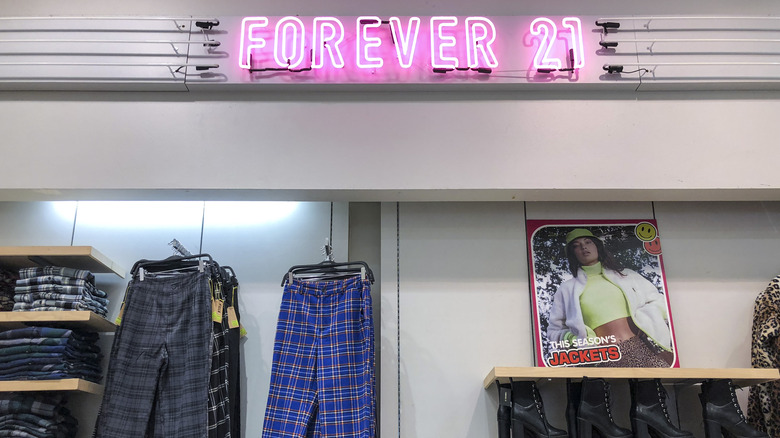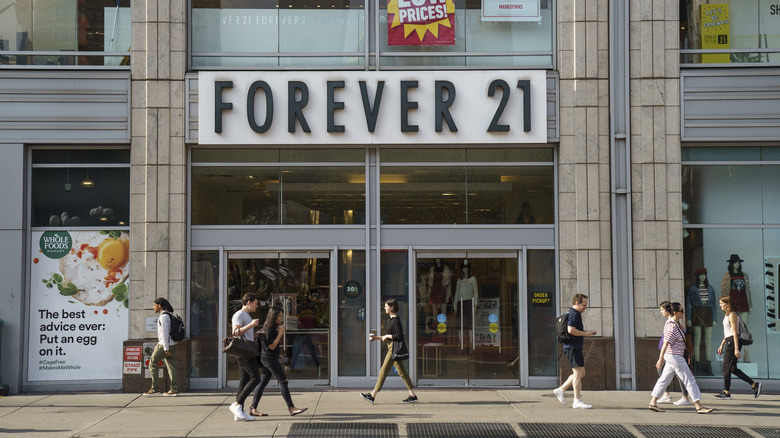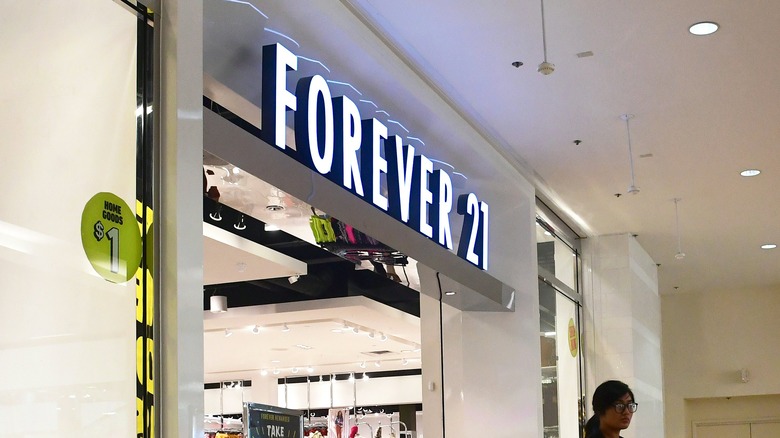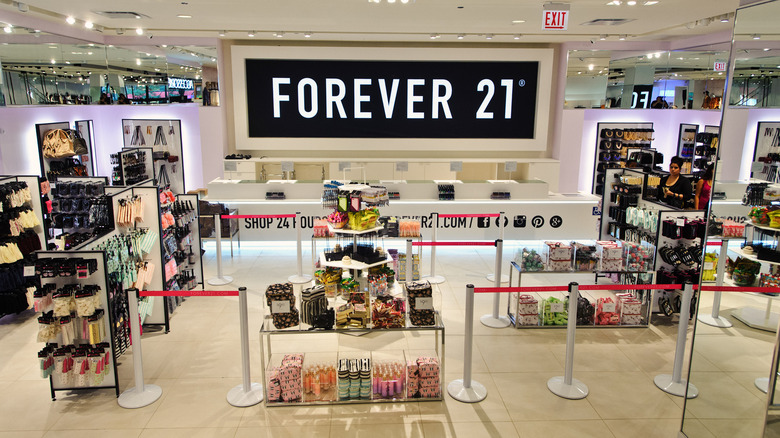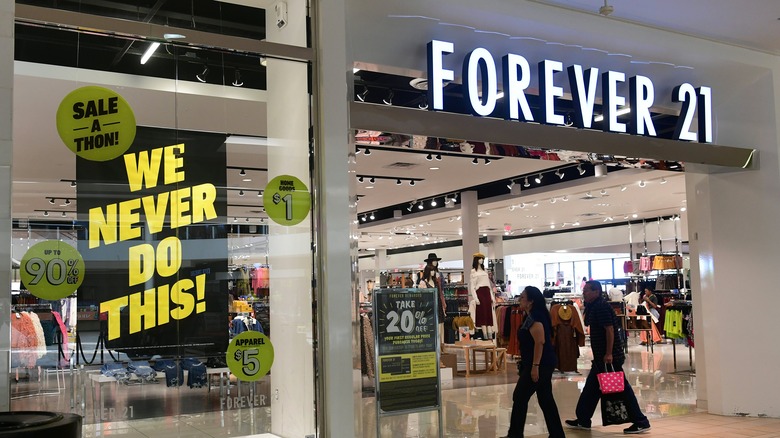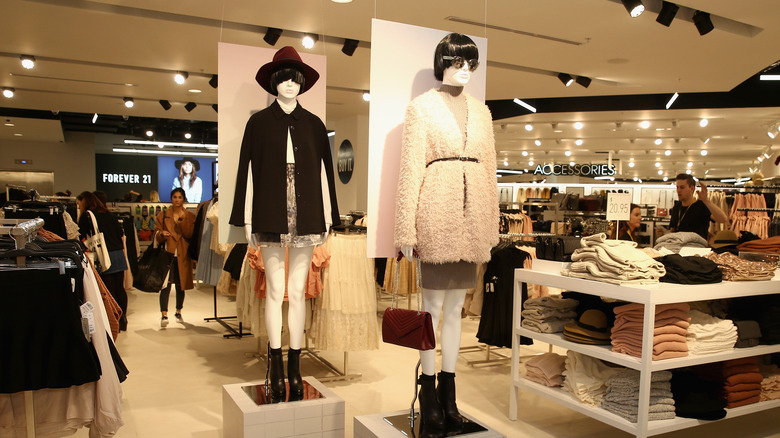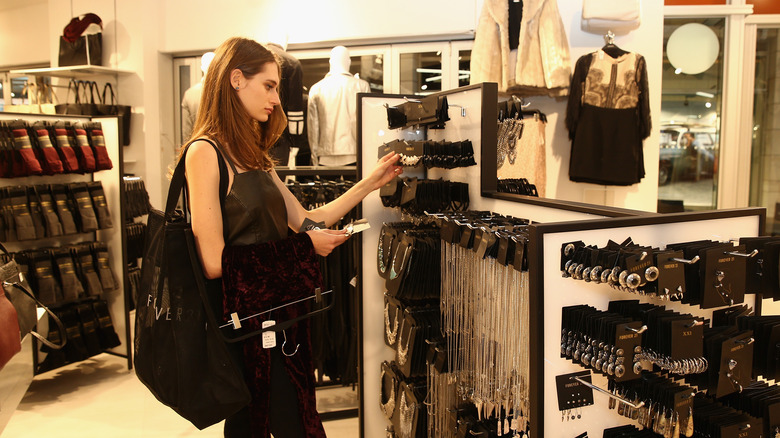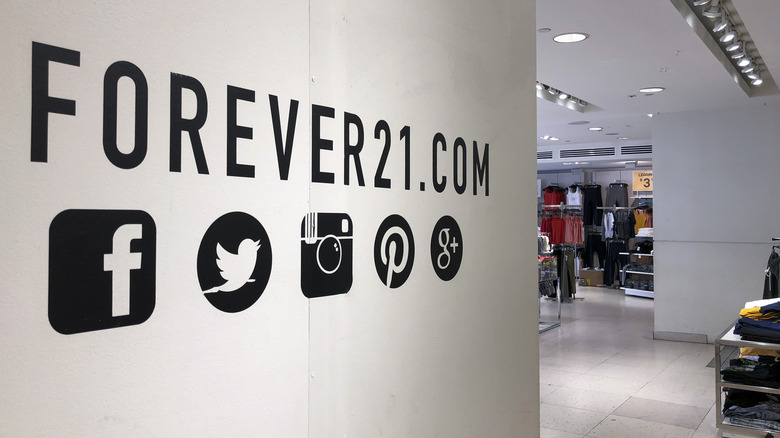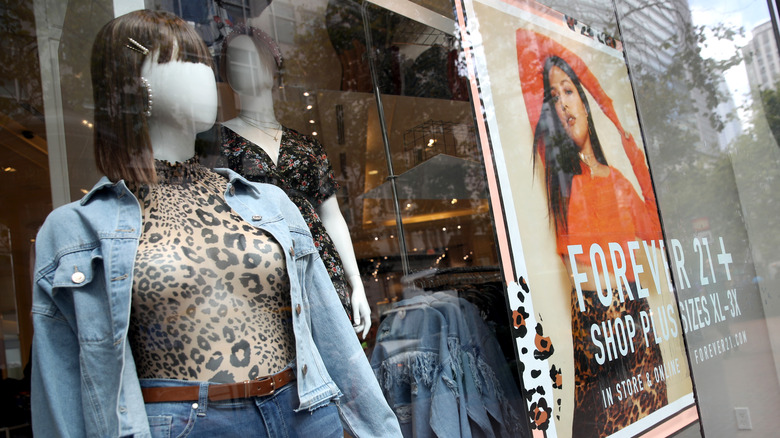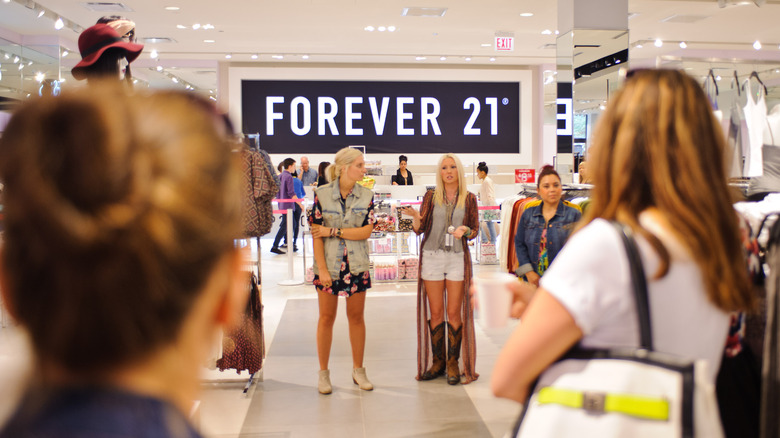The Real Reason Forever 21 Filed For Bankruptcy
Fast fashion retailer Forever 21 announced in late September 2019 that it had filed for Chapter 11 bankruptcy. "This was an important and necessary step to secure the future of our Company, which will enable us to reorganize our business and reposition Forever 21," Linda Chang, the executive vice president of Forever 21, Inc., revealed in a statement to Business Wire. A spokesperson for Forever 21 told CNBC that the company was looking to close as many as 178 stores in the United States and withdrawal from the majority of their locations in Asia and Europe.
It's hard to imagine a mall without a staple Forever 21 store, but that's a very real possibility. The clothing store giant, which was founded in 1984, thrived during the Great Recession due to the brand's affordable prices, CBS News reported. With the American economic crisis mostly behind us, Forever 21 is at risk at being left behind. That's not to say Forever 21 was simply a victim of a better economy. No, this is where Forever 21 went so wrong and the truth behind the company's bankruptcy filing.
Forever 21 couldn't compete with online stores
Forever 21 is far from the only company to have filed for bankruptcy in 2019. Many other well-known mall tenants, such as Gymboree, Charlotte Russe, Things Remembered, and Payless ShoeSource, also filed for bankruptcy the same year. Still, Forever 21 was unique from other brands. CBS News noted, "Forever 21 helped popularize fast fashion in the 2000s by hawking trendy but affordable clothes before they had even made it off the runway." Despite the company's ability to churn out new styles quickly, more and more consumers started shopping online, and, before long, the formula that made Forever 21 so popular led to its downfall.
"There are risks in the fast-fashion model," Greg Portell, lead partner at consulting firm A.T. Kearney, explained to the publication. "There is less margin for error — particularly as companies grow. If a retailer misreads the trends, they end up with the wrong inventory positions at higher volumes."
Forever 21 expanded too far, too fast
At the height of Forever 21's popularity, the company generated $4.4 billion in revenue, according to Business Insider. Around that time, the brand also began rapidly expanding. Time reported that, in just six years, Forever 21 went from having stores in seven countries to an impressive 47 countries. But all the while, the company ignored their biggest competition: online shopping. Just as the brand was working to quickly open more locations, e-commerce was taking off in a big way.
The choice to keep expanding in spite of heightened online competition helped lead Forever 21 into $500 million in debt, data from research firm Mintel provided to CBS News confirmed. "In order to get the business back on track, lenders would have to be willing to pump more money into it and this could be a hard sell," Chana Baram, retail analyst at Mintel, explained in a statement. "Only time will tell what will happen, but these are certainly troubling times for the fast-fashion retailer."
Being in malls didn't help Forever 21
As part of Forever 21's vast expansion plan, the brand increased its presence in shopping malls — "even as foot traffic dwindled," CBS News noted. "It also opened many big-box format stores, averaging about 38,000 square feet, despite the high overhead costs."
Adding more locations to malls was certainly a risk and, unfortunately, one that did not pay off. "I expect store closures to accelerate in 2019, hitting some 12,000 by year end," Deborah Weinswig, founder and CEO of retail research company Coresight, predicted when speaking to CNBC.
This doesn't necessarily mean that malls will disappear, though. "I think this is a multiyear transition," DJ Busch, an analyst at commercial real estate services firm Green Street Advisors, told the publication. "Cleanse out some of these retailers that lasted longer than they should have. ... It's going to be tough. Anyone who thinks otherwise is too optimistic. But it doesn't mean this is a dead business. ... It can continue to be a good business as underproductive [retailers] go away, and the strong landlords invest." While that may be good news for malls, it's certainly not for Forever 21.
Forever 21 got caught up in controversy
Just a few weeks before Forever 21 filed for bankruptcy, singer Ariana Grande sued the fast fashion retailer Forever 21 for using her "name, image, likeness and music" without her permission, according to court records cited by Fox Business. Forever 21 first attempted to reach an endorsement deal with the singer, but Grande passed on the offer "due to Forever 21's unwillingness to pay the fair market value for a celebrity of Ms. Grande's stature." The lawsuit claimed that Forever 21 then used Grande's likeness by "hiring a look-a-like model and posting photos of that model" instead.
Ariana Grande fans may have been miffed by Forever 21's decision, but the consequences of the controversy likely far outreached just admirers of the singer. American shoppers want to shop with brands they can trust. A Sprout Social survey revealed that 86 percent of American consumers find "transparency from business" to be "more important than ever before."
Forever 21 is no stranger to scandal
If Ariana Grande's $10 million lawsuit against Forever 21 was the only major controversy in which the company was involved, consumers could maybe look the other way. But Grande's lawsuit was not at all the first time the retail giant had ruffled shoppers' feathers.
In December 2018, Forever 21 used a white model to advertise the brand's Blank Panther-style sweater, which offended many. Forever 21 apologized in a statement (via Women's Wear Daily) for causing offense and noted that it "takes concerns on [its] products and marketing extremely seriously."
Nearly two years earlier, Forever 21 released a terrifying men's graphic tee with the statement "don't say maybe if you want to say no" in large, bold print. Cosmopolitan dubbed the tee "horrifying" and "very rapey," and, uh, yeah. The brand later removed the t-shirt from its site and provided a statement, apologizing for causing offense.
Forever 21 lost its unique edge
Forever 21 has focused mostly on producing trendy, runway-inspired clothes, and, although Forever 21 was by no means a small boutique, the brand's mass-produced clothing "still felt unique," Business Insider revealed. Why? Because the retailer "only sold select styles for a limited time."
That changed when Forever 21 started rapidly expanding. Soon its styles didn't seem so one of a kind anymore. No, the clothes all started to blend together and look the same. "As a result, Forever 21 started to lose touch with its core customers, while competitors like H&M and Zara rose," the publication reported. "No longer the trendsetter, Forever 21 became the butt of the joke." Forever 21, which was once able to churn out budget-friendly runway recreations in an impressively short amount of time, also started becoming sluggish when compared to newer fast fashion retailers, like the online brand Fashion Nova.
The quality of Forever 21's products took a hit
Among the reasons Forever 21 is at risk of going under is the brand's declining quality, Stacey Widlitz, president of SW Retail Advisors, told the Associated Press. And Widlitz isn't the only one who has noticed this. Consumers have taken to social media to voice their frustrations with the brand's clothing. "Forever 21's quality [is] trash," one shopper tweeted. Another consumer noted the brand's "[ill-fitting] clothing and poor quality."
In the company's bankruptcy filing, Forever 21 itself even acknowledged its declining quality, according to CNBC. Although many think the company's accelerated expansion is mostly responsible for causing its downfall, Bill Read, executive vice president of leasing, acquisitions, and business development at Retail Specialists in Birmingham, Ala., has a different opinion. "I think [Forever 21] is more a victim of people not wanting their clothes to fall apart," he told the publication. "But I think they can survive if they right-size the ship and keep their better stores."
Forever 21 failed to adapt
Whether you think Forever 21's decision to grow too fast or its poor quality clothing is mostly to blame for the company's bankruptcy filing, there's still more to the story. "The world has changed," Stacey Widlitz, president of SW Retail Advisors, told the Associated Press, "and Forever 21 didn't change with it." She continued, saying, "And the walls closed in, in terms of the competition."
In the decade before Forever 21 filed for bankruptcy, online fast fashion retailers started offering customers a quick way to shop the latest styles without leaving their houses. Not only that, but Widlitz noted that the competitors' sites are "curated better and they're fun."
Younger consumers also started to care more about the sustainability of their clothing and started to appreciated "micro trends" over big ones. Forever 21, however, didn't adapt to keep up with either. Sonia Lapinsky, the managing director of the retail practice at AlixPartners LLP, said Forever 21 would "need to deliver the right products, the right story, and be sustainable" if it is to survive.
Forever 21 became "too much of a department store"
As Sonia Lapinsky, the managing director of the retail practice at AlixPartners LLP, noted, Forever 21 would have to start delivering "the right products" in order to bounce back from bankruptcy. That would likely mean scaling back their offerings. As Forever 21 expanded its number of stores across the world, the categories of products the brand offered also grew. The Los Angeles Times noted that it no longer just offered clothes for young women, but "expanded into menswear, children's clothing, maternity and plus-size apparel and cosmetics, among other items."
Although diversifying their products to attract more people may not have sounded like a bad idea at the time, it only further alienated their young consumers. Ilse Metchek, president of the California Fashion Association trade group, said today's teenagers who are looking to buy fast fashion tend to already have an idea of what they want before they get to the store. As such, she said they "want to get in, they want to see it, they want to buy it and get the hell out of there. ... They don't want to go upstairs. It's too much of a department store."
Forever 21 could still be forever
The odds may be stacked against Forever 21, but the company isn't necessarily a goner. A study conducted by the International Council of Shopping Centers revealed that the majority of Generation Z shoppers prefer shopping in-store rather than online. "The more traditional retailers haven't really thought about this particular generation as an attractive target. They haven't really thought about what this group wants out of a shopping experience," Neil Saunders, an analyst at GlobalData Retail, told Bloomberg.
Forever 21 also has quite the online presence — which will come in handy for attracting the younger generation. In 2015, the fashion retailer was ranked as the fourth most-followed company on Instagram, but, at the time, the company was busy targeting millennials. However, Generation Z is actually even more likely to purchase something they see advertised on social media, the International Council of Shopping Centers study revealed.
It's true that Forever 21 will need to make some big changes in order to bounce back from bankruptcy, but it could still live on indefinitely or, you know, forever.

